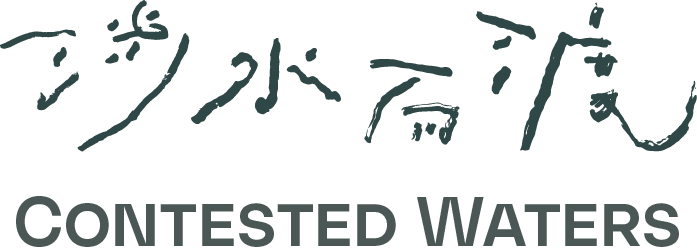從河至海
文:謝一誼
2024 年過世的重要政治理論學者 James Scott,一輩子寫作論述皆聚焦於無法被治理的世界、無法被管控的人群、以及無法被馴化的河流。他逝後出版的新書 In Praise of Floods: The Untamed River and the Life It Brings ( 向洪泛致敬:不被馴化的河流與它帶來的生命 ),序言裡寫他青少年時曾經掉落溪水,差點被沖走;也寫到他和水利工程專家談話時,對方對於每一滴水都要被利用、流入海的河水都是浪費的工程腦,James Scott 感到和這些人,基本上無話可說。
大約 10 歲,在龍崗外婆家前的大排,我也曾自己騎腳踏車直直掉入大排,滿身傷、從水和泥巴中爬出。另一次迷航於溪河,是在關渡宮。年幼的我與父母走散,不太清楚是什麼力量,把我拉離人群,往淡水河寬闊的隘口走去。是三百年前郁永河的呼喊嗎?要我往 1697 年郁永河「海船由淡水港入,前望兩山夾峙處,曰干答門、水道甚隘,入門,水急廣,漶為大湖,渺無涯矣」,那個康熙台北湖、漫漫洪水裡去嗎?
溪河的構成,從來就不只是水;季節性洪泛所創造出的流域,也不只是治理者亟欲控制生態變動的躁進基礎建設。洪泛的河,不被治理的河,繞著動態水文而形成的潟湖與周遭淺山,都是生命湧現的動態,包含了河中的魚、蝦、水泡裡的氧氣、水岸上的植物與水鳥、烏龜和彈塗魚。人類學家 Elizabeth Povinelli 寫澳洲原住民的溪流,是一條河、是一個神話、也是一個年輕女孩;是不斷變化、活生生的存有。即便是 2010 年台灣經濟部水利署的基隆河治理報告,仍用了好幾個「忽然」和「自由」,描述盆地裡一條蜿蜒河流,不受控制的生命渠道:
基隆河自上游平溪區菁桐開始約 13 公里,流向呈東北東,流經菁桐坑、平溪、十分寮、大華至三貂嶺附近,忽然折向北與北北東流經侯硐、瑞芳,流約 5 公里,至瑞芳區之東又突然轉為西南西之流路,於寬闊之河床中曲流約 14 公里,途經四腳亭、暖暖至八堵,再轉向西南,呈顯著之曲流,由汐止附近進入臺北盆地。入臺北盆地後更呈顯著之自由曲流,最後於關渡隘路匯入淡水河。
不被治理,是潮濕生命的基本樣貌;不被控制的洪泛,是地球生命不斷改變、是河流與季節互動的動態樣貌。也因此,科技哲學家 Isabelle Stengers 說,我們與地球生態之間的關係,比較接近魔法 (magic),是一種期待與推想 (wishful thinking),而非某種絕對的控制理性。
涉水而渡 Contested Waters 邀請到當代台灣、印度、芬蘭的青年藝術家,一起思考 Stengers 所說的魔法。這些長時間田野研究裡發展出來的藝術作品,也回應 Paul Gilroy 在《黑色大西洋》一書中提出的世界:我們應當轉移有關生存和移動的視角,從陸地到海洋,從汽車到船隻。因為我們所知的現代,是建築在一船一船從非洲被運送到歐洲與美洲的奴隸們。這些潮濕路徑也提醒我們,如同 1950 年代第一代的深海潛艇,其構造原型,模仿的是座頭鯨。這些潮濕路徑與潮濕生命,都以潮濕美學的形式,深埋在我們身邊;即使說今天,大多數的我們已如這第一代潛艦,擱淺陸地、喪失游移於海的能力;而各種形式的水體,已然被水壩、水庫、數位水利工程等設施積極地資本化、軍事化,抑或變成可量化控制的乾燥數字、僅僅成為能被榨取、被動的資源。
從河至海,我們重新來過?
From the River to the Sea
by I-yi Hsieh
James Scott, the renown political theorist who passed away in 2024, spent his life addressing the world that cannot be governed, the people that cannot be controlled, and the riversthat cannot be domesticated. In the preface to his posthumously published book, In Praise of Floods: The Untamed River and the Life It Brings, Scott writes his experience of falling into a stream and was nearly swept away. He also wrote that at one occasion he was set to sit next to some hydraulic engineer, to whom he lamented about a river that never got to the sea. The hydraulic engineer countered Scott’s sentiment by saying that every drop of water should be used, and any river water flowing into the sea is a waste. Scott found himself having little to talk to this hydraulic engineer.
When I was about 10 years old, I also rode my bike straight intothe stream in front of my grandmother’s house. Covered with injuries and mud, I crawled out of the river. Another time I got lost by the river was at the Guandu Temple by the Tamsui River, the major river in the Taipei Basin. I was separated from my parents, and an unknown force pulled this young child away from the crowd, towards the wide pass of the Tamsui River. Is it the cry of Yu Yonghe three hundred years ago that called me? In 1697, Yu, then the Qing officer sent to explore sulfur mines in Beitou, wrote that his “sea ship enters from the Tamsui port, looking at the place between the two mountains called the Gandamen; the waterway is very narrow, the entrance is wide, the water runs fast, and the river turns into a big lake with no end.” Was I pulled by the ghost of Yu toward this Taipei Lake that made the Taipei basin as we know today?
Streams and rivers are composed more than just water. The watersheds created by seasonal flooding are not just a subject of control for zealous hydraulic infrastructures – floods bring necessary ecological changes. Flooded rivers, untamed rivers, lagoons and watersheds formed dynamic hydrology and shallow mountains where dynamics of life take place.
Anthropologist Elizabeth Povinelli writes in her ethnography that the stream for Australia Aboriginals is a river, a myth, and a young girl as well; to them a changing and living being. Even in the 2010 management report of the Keelung River, commissioned by the Water Resources Administration of Taiwan’s Ministry of Economic Affairs, several phrases such as “suddenly” and “freedom” appear to describe the notoriously meandering river in the basin:
The Keelung River starts about 13 kilometers from Jingtong in Pingxi District in the upper reaches, flows northeast to east, flows through Jingtong Keng, Pingxi, Shifenliao, Dahua to the vicinity of Sanering, suddenly turns north and north-north-east flows through Hou Tong and Ruifang, flows about 5 kilometers, and suddenly turns into a southwest-west flow path to the east of Ruifang District, meanders about 14 kilometers in the wide riverbed, passes through Sijiaoting, Nuan Nuan to Badu, and then turns to the southwest, showing a significant meandering, entering the Taipei Basin from the vicinity of Xizhi. After entering the Taipei Basin, it shows a significant style of freedom to meander, and finally joins the Tamsui River at Guandu Pass.
Not being governed is the basic form of life. Uncontrolled flooding is the result of the planetary ecological changes, the dynamic interaction between rivers and seasons. That is also why the philosopher of science and technology Isabelle Stengers notes that our ecological relationship with the earth is closer to magic, a kind of wishful thinking, rather than something reducible to absolute control of human rationality.
The Taiwanese, Finish, and Indian artists in this exhibition lead us toward thinking about this magic. Contested Waters echoes the thesis that Paul Gilroy, in the Black Atlantic, puts forward: it is about time we shift the metaphor and narratives of the world from cars and buses on land, to boats, ships, and rafts— floating life containers and deep dive utensils at sea, including the first generation of submarines in the 1950s shaped as a whale however is now stuck on land, broken. What Gilroy draws attention to is that the modernity we know it today is constructed by the slaves shipped across the Atlantics, from Africa into Europe and the Americas. They remind us the liquid routes and wet aesthetics embedded in us despite the levees, dams, digital hydro-engineering facilities reducing aquatic lives into either capitalized and militarized zones or dried quantities to be easily extracted, blocked, and thus denied agency.
From the river to the sea, shall we give the magic a try again?
